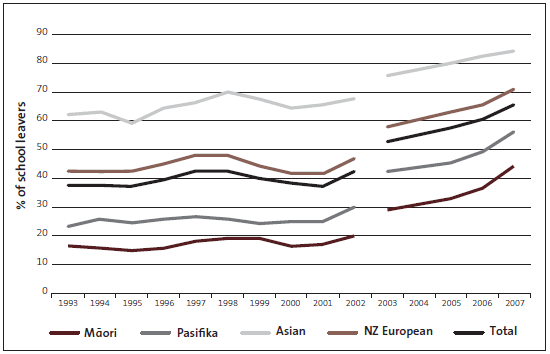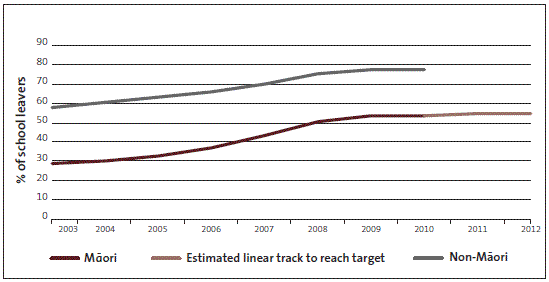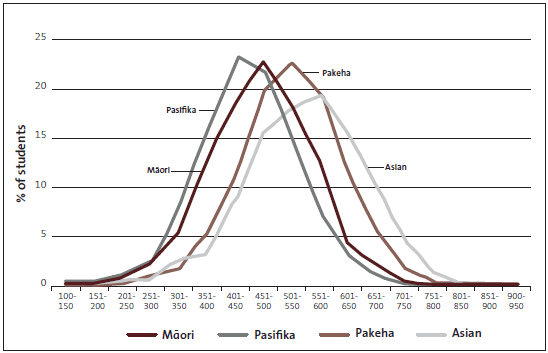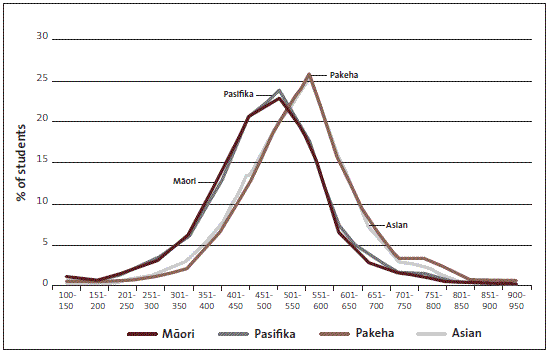Part 3: Historical and current context for Māori education
3.1
In this Part, we set out some historical information about the education system's approach to Māori, and data on the current status of Māori educational achievement. We then describe what some of the leading research shows about the effectiveness of, barriers to, and opportunities in educational achievement for Māori.
Māori educational policy and developments since 1816
3.2
Figure 1 shows a timeline of major policy decisions and developments in the history of education for Māori, from 1816 to 2012.
3.3
Commentators have noted that the policies described in Figure 1 disadvantaged many Māori within the state education system. For example, the Waitangi Tribunal noted in The Wānanga Capital Establishment Report:
It would not be difficult to argue that the seeds of Māori underachievement in the modern education system were sown by some of the past education policies ...18
Deficit thinking
3.4
As Figure 1 shows, there have been several changes in policy and approach to Māori education during the past 30 years.
Ministry of Education
3.5
In the late 1980s and 1990s, government policy reflected the attitude that socio-economic and not ethnic factors were the root cause of underachievement (not just for Māori). This resulted in educators focusing on social backgrounds, parenting, and other societal influences. This has been described by the Ministry and other commentators as "deficit thinking" – thinking about Māori students in terms of what they lack. Researchers have noted that this can lead to educators thinking that problems lie with the student, not the teacher or the system.
3.6
Since 2002, there has been a shift in policy to reject "deficit thinking". Policy initiatives intended to improve services to Māori, such as "Ka Awatea" (1991) and "Closing the Gaps" (1999), were reconsidered because they were seen to reflect deficit thinking.19
Figure 1
Dates and events related to Māori education policy and developments, 1816-2012
| 1816 | First mission school opens in the Bay of Islands. Missionaries teach in te reo. |
| 1840 | Signing of the Treaty of Waitangi. |
| 1847 | George Grey introduces the Education Ordinance Act (an assimilation policy). |
| 1862 | Government expectations of Māori are not high. School inspector reports to the House of Representatives that "a refined education or high mental culture" would be inappropriate for Māori because "they are better calculated by nature to get their living by manual than by mental labour". |
| 1867 | Native Schools Act is passed, setting up a system where Māori provide the land and the Government provides the buildings and teachers. (The Act prefers English as the only language used in the education of Māori children, but this was not enforced rigorously until 1900.) Schools for Māori focus more on manual instruction than academic subjects. |
| 1880 | Inspector of Schools releases a Native School Code. Te Aute College produces first Māori graduates in the 1880s, but the College comes under pressure to abandon the academic curriculum and teach agriculture instead. |
| 1903 | Nationwide policy to impose a ban on (or discourage) te reo being spoken in the playground. A wide range of punishments used against children who speak te reo at school (including corporal punishment). |
| Addendum There is a range of views on whether there was a policy to ban te reo Māori in Native Schools. The Waitangi Tribunal in its 1986 Report on the Te Reo Māori claim (page 9) said that "on what we have heard it was clearly at least a practice widely followed that during the first quarter of this century Maori children were forbidden to speak Maori in school, even in the playground, and that they were punished if they did so … We will shortly outline the consequences of this policy (because we think it was more than just a practice)." However, in its 2020 Report on the Te Rohe Pōtae claims (page 212), a later Tribunal found that "the Education Department appears to have stopped short of issuing a blanket ban against the use of te reo in schools." |
|
| 1915 | Department of Education has an assimilation policy for Māori and low expectations of Māori students. Annual report includes statement from the Inspector of Native Schools that "So far as the Department is concerned, there is no encouragement given to [Māori] boys who wish to enter the learned professions. The aim is to turn, if possible, their attention to the branches of industry for which the Māori seems best suited." |
| 1930/31 | Attempt by the New Zealand Federation of Teachers to have te reo introduced into the curriculum is blocked by the Director of Education. In his view, "the natural abandonment of the native tongue involves no loss to the Māori". Director of Education states that education "should lead the Māori lad to be a good farmer and the Māori girl to be a good farmer's wife". |
| 1950 | Western influences begin to affect Māori families, who start to raise their children as predominantly English speakers. |
| 1960 | Hunn Report draws attention to the educational disparity between Māori and Pākehā, and rejects the assimilation policy in favour of "integration". (Between 1900 and 1960, the proportion of Māori fluent in te reo decreases from 95% to 25%.) |
| 1963 | Currie Report emphasises the need to centralise the notion of Māori educational underachievement and initiates a range of compensatory education programmes. |
| 1970 | Ngā Tamatoa and the Te Reo Māori Society lobby for the introduction of te reo in schools. |
| 1971 | Report of the National Advisory Committee on Māori Education advances the concept of bicultural education. |
| 1973 | All seven Teachers Colleges have courses in Māori Studies. Presentation of Māori language petition to Parliament by Ngā Tamatoa and the Te Reo Māori Society. |
| 1981 | Hui Whakatauira of Māori leaders proposes and establishes the first kōhanga reo as a response to impending loss of te reo. |
| 1985 | First kura kaupapa Māori established at Hoani Waititi Marae, West Auckland. |
| 1986 | Report of the Waitangi Tribunal on the Te Reo Māori Claim (WAI 11) asserts that te reo is a taonga guaranteed protection under Article II of the Treaty of Waitangi. |
| 1987 | Māori Language Act recognises te reo as an official language. Māori Language Commission (Te Taura Whiri i te Reo Māori) is established. |
| 1989 | Education Act formally recognises kura kaupapa Māori as educational institutions. |
| 1990 | Education Act is amended to recognise wānanga as educational institutions and allow the Minister of Education to designate a state school as a kura kaupapa Māori. |
| 1997 | Strong push from Māori involved in initiatives to increase the numbers of speakers of te reo. There are 675 kōhanga reo (catering for 13,505 children), 54 kura kaupapa Māori, three wānanga, more than 32,000 students receiving Māori-medium education, and 55,399 students learning te reo. |
| 1998 | Te Puni Kōkiri report identifies education system's underachievement for Māori. First Māori education strategy developed by Ministry of Education and Te Puni Kōkiri. |
| 1999 | Education Act is amended to make it mandatory for kura kaupapa Māori to adhere to Te Aho Matua principles. |
| 2001-05 | Series of Hui Taumata initiated by Minister and Associate Minister of Education and Ngāti Tūwharetoa to debate issues, barriers, and future directions. Redevelopment of Māori education strategy, drawing on Te Puni Kōkiri's "Māori Potential Approach" policy. |
| 2008 | Launch of strategy for improving the performance of the education system for Māori, Ka Hikitia – Managing for Success. |
| 2012 | Range of initiatives, programmes, and activities to implement more self-determined approach to Māori education. (Includes iwi partnerships, ECE participation projects, and professional learning and development programmes.) |
Sources include: Ka'ai, T (2004), "Te mana o te reo me ngā tikanga Power and politics of the language", in Ka'ai, T et al., Ki Te Whaiao – An Introduction to Māori Culture and Society, Pearson, Auckland, pages 202-204, and Waitangi Tribunal (1999), The Wānanga Capital Establishment Report, chapter 2, pages 6-7. Williams, D (2001), Crown Policy Affecting Maori Knowledge Systems and Cultural Practices, Report to the Waitangi Tribunal, chapter 3, pages 150-151.
3.7
Originating with the Māori Potential Approach from Te Puni Kōkiri, government policy moved towards considering Māori achievement in terms of opportunity. Research published by the Ministry in 2007 found that students participating in kura kaupapa Māori (where the school culture and teaching practices reflect Māori values and concepts) achieved more highly than Māori students in English-medium schools.20
Current context of Māori educational achievement
3.8
Figures 2 to 8 set out the most recent publicly available data we could find on educational achievement and retention rates. Although there have been improvements, the figures show that the education system is not serving Māori students as well as it serves other students.
Figure 2
Percentage of school leavers who have attained few or no formal qualifications, 1993-2007

Source: Organisation for Economic Co-operation and Development (2010), Review on Evaluation and Assessment Frameworks for Improving School Outcomes – New Zealand Country Background Report 2010.
Figure 3
OECD's figures on percentage of school leavers with NCEA Level 2 or higher, 1993-2007

Source: Organisation for Economic Co-operation and Development (2010), Review on Evaluation and Assessment Frameworks for Improving School Outcomes – New Zealand Country Background Report 2010. Note: The gap in the lines on this graph between 2002 and 2003 is deliberate and indicates the change in the qualification measure used at Year 12. From 2003, the qualification measure used is NCEA Level 2.
Figure 4
Ministry of Education's figures on percentage of school leavers with NCEA Level 2 or higher, 2003-10

Source: Ministry of Education. The Ministry's target is to increase the percentage of Māori school leavers with NCEA Level 2 or above from 36.7% in 2006 to 55% in 2012.
3.9
Figures 2 to 4 show that the gap between school leavers without qualifications and school leavers with NCEA Level 2 or above narrowed between 2002 and 2008.21 However, Figure 5 shows that a lower proportion of Māori students achieve NCEA qualifications than other ethnic groups, and Figure 6 shows that Māori students are still far more likely to leave school earlier than their non-Māori peers. As a result, Māori students leave school with fewer qualifications than other students.
Figure 5
Tracking achievements of students who enrolled for NCEA Level 1 in 2009, as at end of 2011
| Ethnicity | Attained Level 1 by end of Year 13 |
Attained Level 2 by end of Year 13 |
Attained Level 3 by end of Year 13 |
No. of candidates in cohort |
|---|---|---|---|---|
| NZ European | 86.0% | 74.1% | 47.0% | 34,292 |
| NZ Māori | 68.3% | 52.6% | 22.7% | 12,249 |
| Pasifika peoples | 75.3% | 63.9% | 26.7% | 5,678 |
| Asian | 84.5% | 78.1% | 54.3% | 6,292 |
Source: NZQA. The percentages are calculated based on the number of candidates in Year 11 in 2009, even though some candidates might have left school before Years 12 and 13.
Figure 6
Estimated percentage of students staying on at school, by age and ethnic group, 2002-08
| Year | Age=16.5 | Age=17.5 | ||
|---|---|---|---|---|
| Māori % |
Total % |
Māori % |
Total % |
|
| 2002 | 62.4 | 80.5 | 36.8 | 57.6 |
| 2003 | 63.5 | 82.6 | 37.3 | 58.7 |
| 2004 | 64.4 | 82.0 | 40.3 | 61.4 |
| 2005 | 64.0 | 81.8 | 40.3 | 61.1 |
| 2006 | 61.5 | 81.2 | 39.7 | 61.3 |
| 2007 | 62.6 | 81.4 | 39.5 | 61.4 |
| 2008 | 65.8 | 82.4 | 40.4 | 62.3 |
Source: Ministry of Education.
3.10
The Ministry's report on Māori education, Ngā Haeata Mātauranga, noted that in 2008, 43% of all male students and 34% of all female students who left school in year 10 were Māori. Of those who left in year 11, Māori students made up 32.8%.22
3.11
In 2006, nearly half of all Māori students who left school had gained no qualifications at any level.23 The Ministry estimated that 32% of all Māori students in 2011 will leave school without gaining qualifications at any level.
3.12
Figures 7 and 8 show Māori students' achievement in mathematics and reading, compared to students in other ethnic groups, based on data from 2001 to 2004. The distribution of achievement is the same for Māori students as it is for other ethnicities, but the position of the bell curves show that most Māori (and Pasifika) students sit lower in the range than others.
Figure 7
Distribution of 90,000 students' assessed achievement in mathematics, by ethnicity, 2001-04

Source: Hattie, J (2008), "Narrow the Gap, Fix the Tail, or Close the Curves: The Power of Words", in Rubie-Davies, C M, and Rawlinson, C, Challenging Thinking about Teaching And Learning, Nova Science Publishers, New York, page 22.
Figure 8
Distribution of 90,000 students' assessed achievement in reading, by ethnicity, 2001-04

Source: Hattie, J (2008), "Narrow the Gap, Fix the Tail, or Close the Curves: The Power of Words", in Rubie-Davies, C M, and Rawlinson, C, Challenging Thinking about Teaching And Learning, Nova Science Publishers, New York, page 21.
What leading research says about barriers to, and opportunities for, Māori educational achievement
Professor Wally Penetito
3.13
To help us further focus our work, we considered leading research into Māori educational achievement. The following section outlines what the research says and builds on the history, policy direction, and achievement statistics detailed in the previous sections.
3.14
The research clearly indicates some of the barriers to, and opportunities for, success that our audit activity could test during the next five years.
Research into reasons for "Māori underachievement"
3.15
"Māori underachievement" has been the subject of much research. Recent research conducted by the Ministry and independent researchers among whānau, students, and education providers indicates what some of the barriers for Māori are.
3.16
Some barriers are more generic and might be common to many students, regardless of their cultural background. Parents and whānau interviewed about participation in ECE noted that factors limiting their participation included physical and economic access to ECE, differing views about the value of ECE, degree of trust in the teacher, and perceived lack of responsiveness by services to cultural needs.
3.17
Research also shows that students can find transitioning from primary to secondary school difficult. This is especially so for students with low achievement levels, of lower socio-economic status, from kura kaupapa Māori, and from diverse cultural backgrounds. However, the Ministry's companion document to Ka Hikitia, Key evidence and how we must use it to improve the system performance for Māori (the Key Evidence document),24 cites research indicating that these difficulties are more accentuated for Māori. These findings are consistent with research that emphasises the importance of relationships for Māori students.
3.18
Research shows that effective leadership to improve student achievement and well-being, positive teacher-student relationships, easy transitions from ECE to primary school and from primary school to secondary school, and access to ECE are all important.
Lower expectations of Māori students and lack of cultural responsiveness
Bishop, O’Sullivan, and Berryman
3.19
Some barriers may be more specific to Māori. The Key Evidence document cites evidence from research indicating lower teacher expectations of Māori students at all levels – and that this has a direct, negative result on those students' achievement. In particular, researchers have found that some teachers' low expectations of students who move from Māori-medium to English-medium schools and a lack of cultural responsiveness in English-medium schools are significant barriers to educational achievement.
3.20
A further barrier identified by research is variable levels of commitment and understanding from the Ministry and other education sector agencies, and in school leadership and teaching practices. Sometimes this can reflect a lack of willingness to change the "cultural tradition" of teaching.25 This can result in a "one size fits all" approach to teaching, which does not suit all Māori students.
3.21
The Key Evidence document notes that recent research has linked improved student achievement to how well a student's culture is reflected in the school's values and teaching practices.26 However, there are difficulties in:
- acknowledging the issues facing Māori students while avoiding deficit thinking; and
- challenging the education system to support culturally responsive education.
3.22
A major challenge noted by the Ministry and other sources is how to measure Māori achievement when that requires determining who the Māori students are and what their needs are without focusing on them in deficit-thinking terms. Also, Ministry staff, ERO, and others noted that many teachers and school leaders express discomfort with what they view as "singling out" their Māori students, believing that all students should be "treated the same".27
3.23
It is clear from the research noted in this section that the barriers to Māori educational achievement are varied and complex. Below, we outline what the leading research indicates is effective in education for Māori.
What the research shows to be effective for Māori students
Advisory Group
3.24
It is clear from our research review that there are successes in Māori educational achievement. It is also worth noting that honest and open dialogue is needed for that achievement to improve. The Advisory Group suggested that "courageous conversations" are needed to help to name the issues – such as whether beliefs about treating all students the same are used to justify a refusal to move to culturally responsive teaching – and make progress towards addressing them. The Advisory Group noted that the challenge for the education sector is to create environments and opportunities for these "courageous conversations" to take place.
Cultural responsiveness
3.25
During the last two decades, many researchers have investigated what works for Māori, independently and on behalf of the Ministry. Examples of good practice that result in Māori students' educational achievement indicate what works for Māori and indeed for many students.
3.26
Research emphasises the importance of cultural responsiveness in all aspects of education. Cultural responsiveness could also contribute to achievement for all students. Professor Sir Mason Durie notes:
… success for Māori students will be more likely where whānau and school can share positive attitudes, aspirations, and expectations.28
3.27
One way of providing culturally responsive education is through Māori-medium schools. (We describe Māori-medium education and its underlying concepts in Appendix 4.) There may be some useful lessons for the wider education system in the approach taken by Māori-medium schools.
Concepts of teaching practices
3.28
According to research, the important aspects of Māori pedagogy (theory and practices of teaching) underpinning teaching practices in Māori-medium schools and kōhanga reo/ECE environments include:
- ako – co-operation of learner and teacher, resulting in fluidity of roles (see paragraph 3.29);
- student-directed learning, resulting in student control over the sequence and pace of learning;
- use of Māori concepts and contexts as a basis for learning; and
- close involvement of whānau and encouragement of whānau participation in classrooms.29
3.29
The research notes that these aspects of pedagogy differ from traditional teaching practices and that they are likely to present a challenge to English-medium teachers who are used to delivering set lesson content in a traditional classroom setting.30 (We note that the trend in general education in recent years, supported by the ECE curriculum Te Whāriki and the New Zealand Curriculum, has been to encourage independent learning by placing greater emphasis on student-directed learning or an inquiry approach.)
3.30
The importance of ako, and of relationships in the classroom, is a strong theme in the research we reviewed. Ako is two-way and collaborative (group) learning in a culturally responsive setting. This requires the teacher to be a learner as well, and allows the student to be a teacher to classmates and the class teacher.
3.31
Manaakitanga (in this context, caring and kindness) is noted by researchers and in Ka Hikitia as fundamental for helping Māori students to achieve. Whānaungatanga (in this context, building supportive relationships) provides positive results for lifting Māori students' achievement.
3.32
In its Best Evidence Synthesis 2009 report on school leadership, the Ministry identified leadership as critical to improving student outcomes in both Māori- and English-medium schools.31
Teacher quality and capability – the pivotal role in communication with whānau
3.33
The research we reviewed emphasises the quality of teaching as a crucial element of educational achievement for Māori students. The Advisory Group noted that teachers are in an important position to promote links to their community and whānau, and need to consider what they do that draws students into school. The challenge for the teacher, as the face of the ECE provider or the school, is how to reach out to whānau/parents and caregivers to gain their support for their children's participation and learning.
18: Waitangi Tribunal (1999), The Wānanga Capital Establishment Report, Wellington, chapter 2.
19: Comer, L (2008), Closing the Gaps – Lessons from New Zealand (presentation to Ministerial Council for Aboriginal and Torres Strait Islander Affairs), Te Puni Kōkiri, Wellington, pages 2, 3, 9, 13.
20: Wang, H and Harkness, C (2007), Senior Secondary Students' Achievement at Maori-Medium Schools 2004 – 2006 Fact Sheet, Ministry of Education, Wellington, in particular, pages 1-2.
21: The Ministry told us that estimates for 2011 show a slight improvement, but the overall picture remains the same.
22: Ministry of Education (2010), "Young People Engaged in Education", Ngā Haeata Mātauranga – The Annual Report on Māori Education, 2008/09, Wellington, page 27.
23: Ministry of Education (2008), Key evidence and how we must use it to improve the system performance for Māori, Wellington, page 27.
24: Ministry of Education (2008), Key evidence and how we must use it to improve the system performance for Māori, Wellington.
25: Graham Nuthall, cited in Ministry of Education (2008), Key evidence and how we must use it to improve the system performance for Māori, Wellington.
26: Ministry of Education (2008), Key evidence and how we must use it to improve system performance for Māori, Wellington, page 33.
27: Education Review Office (2012), Partnerships with Whānau Māori in Early Childhood Services, Wellington, page 12.
28: Durie, M (2011), Ngā Tini Whetū – Navigating Māori Futures, Huia Publishers, Wellington, page 5.
29: Ka'ai, T (2004) "Te mana o te reo me ngā tikanga Power and politics of the language", in Ka'ai T et al., Ki Te Whaiao – An Introduction to Māori Culture and Society, Pearson, Auckland, pages 202-204, 208.
30: Rangahau Matauranga Māori, Te Kotahitanga: The experiences of Year 9 and 10 Māori students in mainstream classrooms, pages 7-10.
31: Robinson, V, Hōhepa, M, and Lloyd, C (2009), School Leadership and Student Outcomes: Identifying What Works and Why – Best Evidence Synthesis Iteration, Wellington, page 35.

